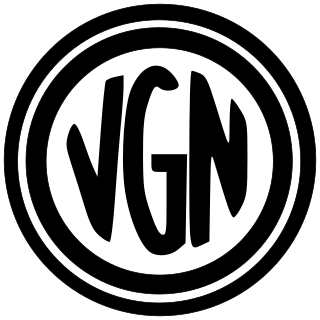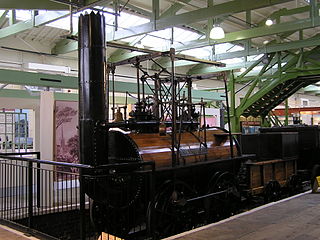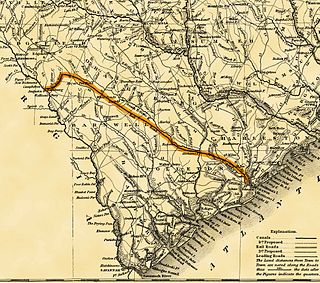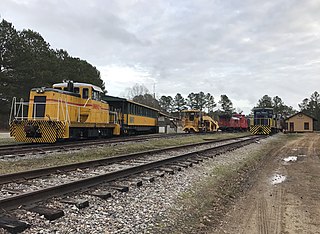
A steam locomotive is a locomotive that provides the force to move itself and other vehicles by means of the expansion of steam. It is fuelled by burning combustible material to heat water in the locomotive's boiler to the point where it becomes gaseous and its volume increases 1,700 times. Functionally, it is a steam engine on wheels.

The Norfolk Southern Railway is a Class I freight railroad operating in the Eastern United States. Headquartered in Atlanta, the company was formed in 1982 with the merger of the Norfolk and Western Railway and Southern Railway. The company operates 19,420 route miles (31,250 km) in 22 eastern states, the District of Columbia, and has rights in Canada over the Albany to Montreal route of the Canadian Pacific Kansas City. Norfolk Southern Railway is the leading subsidiary of the Norfolk Southern Corporation.

The Virginian Railway was a Class I railroad located in Virginia and West Virginia in the United States. The VGN was created to transport high quality "smokeless" bituminous coal from southern West Virginia to port at Hampton Roads.

The Southern Railway was a class 1 railroad based in the Southern United States between 1894 and 1982, when it merged with the Norfolk and Western Railway (N&W) to form the Norfolk Southern Railway. The railroad was the product of nearly 150 predecessor lines that were combined, reorganized and recombined beginning in the 1830s, formally becoming the Southern Railway in 1894.

Locomotion No. 1 is an early steam locomotive that was built in 1825 by the pioneering railway engineers George and Robert Stephenson at their manufacturing firm, Robert Stephenson and Company. It became the first steam locomotive to haul a passenger-carrying train on a public railway, the Stockton and Darlington Railway (S&DR).

The Norfolk Southern Railway was the final name of a railroad that ran from Norfolk, Virginia, southwest and west to Charlotte, North Carolina. It was acquired by the Southern Railway in 1974, which merged with the Norfolk and Western Railway in 1982 to form the current Norfolk Southern Railway.

The South Carolina Canal and Rail Road Company was a railroad in South Carolina that operated independently from 1830 to 1844. One of the first railroads in North America to be chartered and constructed, it provided the first steam-powered, scheduled passenger train service in the United States.

Southern Railway 4501 is a preserved Ms class 2-8-2 "Mikado" type steam locomotive. Built in October 1911 by the Baldwin Locomotive Works in Philadelphia, Pennsylvania, No. 4501 was the first of its wheel arrangement type for the Southern Railway (SOU). In July 1948, the locomotive was retired from revenue service in favor of dieselization and was subsequently sold to the shortline Kentucky and Tennessee Railway (K&T) in Stearns, Kentucky, to haul coal trains.

The New Hope Valley Railway is a heritage railroad in Bonsal, North Carolina operated by the North Carolina Railway Museum, Inc., an all-volunteer, nonprofit, and tax exempt educational and historical organization.
The Norfolk and Western J class was a class of 14 4-8-4 "Northern" streamlined steam locomotives built by the Norfolk and Western Railway (N&W) at its Roanoke Shops in Roanoke, Virginia, between 1941 and 1950. The most powerful 4-8-4 locomotives ever produced, the J class were part of the N&W's "Big Three" that represented the pinnacle of steam technology.

The William Aiken House and Associated Railroad Structures make up a National Historic Landmark District in Charleston, South Carolina, that contains structures of South Carolina Canal and Railroad Company and the home of the company's founder, William Aiken. These structures make up one of the largest collection of surviving pre-Civil War railroad depot facilities in the United States. The district was declared a National Historic Landmark in 1963.

Southern Railway 630 is a Ks-1 class 2-8-0 "Consolidation" type steam locomotive built in February 1904 by American Locomotive Company's Richmond Works of Richmond, Virginia for the Southern Railway (SOU) as a member of the Ks-1 class. It was primarily assigned to haul freight trains on the Murphy Branch between Asheville and Murphy, North Carolina until its retirement in August 1952. No. 630, along with sister locomotive No. 722, were sold to the East Tennessee and Western North Carolina Railroad (ET&WNC) to be served as switchers.

Southern Railway 722 is a Ks-1 class 2-8-0 "Consolidation" type steam locomotive built in September 1904 by the Baldwin Locomotive Works to run on the Murphy Branch, where it hauled freight trains between Asheville and Murphy, North Carolina for the Southern Railway (SOU). In 1952, it was purchased by the East Tennessee and Western North Carolina Railroad (ET&WNC), alongside its sister locomotive No. 630, where they were served as switchers around Johnson City and Elizabethton, Tennessee.

Norfolk and Western 611, also known as the "Spirit of Roanoke" and the "Queen of Steam", is the only surviving example of Norfolk and Western's (N&W) class J 4-8-4 type "Northern" streamlined steam locomotives. Built in May 1950 at N&W's Roanoke Shops in Roanoke, Virginia, it was one of the last mainline passenger steam locomotives built in the United States and represents a pinnacle of American steam locomotive technology.

The Finley Roundhouse is a historic railway roundhouse located in the Acipco-Finley neighborhood of Birmingham, Alabama. It is one of the last two surviving railway roundhouses in the City of Birmingham and one of three surviving in the State of Alabama. It is also the largest reinforced concrete roundhouse in Alabama. It was built by the Southern Railway in 1915.

The Flying Dutchman was an American horse-powered locomotive operated by the South Carolina Canal and Railroad Company. It was built in New York by engineer Christian Edward Detmold and won an 1830 locomotive competition. Driven by a horse on a treadmill, it could carry 12 passengers at a speed of around 12 miles per hour (19 km/h). The South Carolina Canal and Railroad Company operated the Flying Dutchman on a 6-mile (9.7 km) stretch of track from early 1830. It was replaced by a steam-powered locomotive, the Best Friend of Charleston, by the end of the year.

The NS 3900 was a series of express steam locomotives of the Dutch Railways. The NS 3900 was the last express steam locomotive specifically designed for the Netherlands. The NS 4000 series was ordered in Sweden during the war, however this series was based on an existing Swedish design.


















